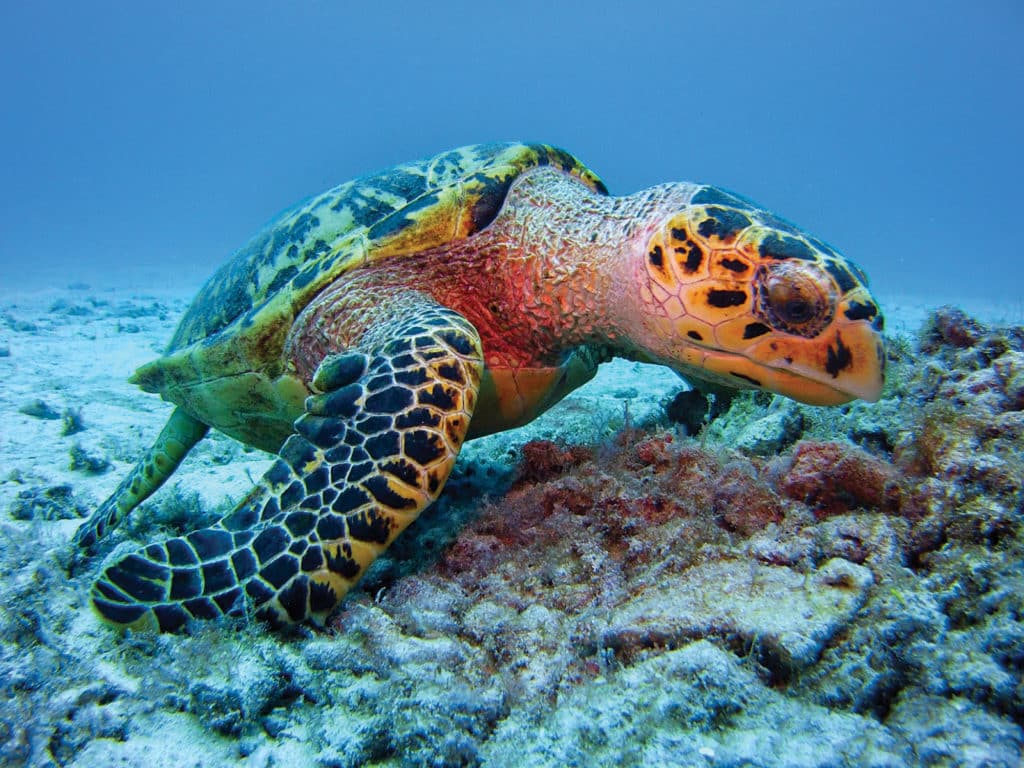
Diving in the Cayman Islands is some of the best diving in the world. The abundance of marine life and amazing coral reefs combined with the islands’ clear, warm water is an unbeatable combination. I love to explore shipwrecks and swim-through coral tunnels, and I love to see sharks during a dive. But my favorite creatures to see in the Cayman Islands are the sea turtles.
My path across the western Caribbean took me 120 miles northwest from Negril, Jamaica, to the Cayman Islands. The sail from Negril on the west coast of Jamaica to Cayman Brac was grand—a flat sea and enough wind to sail at 6 knots with Sonic Boom, my 1969 Elizabethan 31, gliding beautifully through the smooth water. When I arrived on Cayman Brac, one of the Caymans’ two ports of entry, I cleared in and moved to one of the free mooring balls. From the mooring I could see clear to the bottom—I peered through the translucent water and enjoyed the show of colorful fish swimming among the coral.
From Cayman Brac, the leg to Little Cayman was a simple 5-mile sail. Little Cayman was my planned jumping-off point for Grand Cayman, which lies 90 miles southwest. Fewer than 100 people live on Little Cayman, and the water was even more translucent than Cayman Brac, if that’s possible. I picked up a ball in Bloody Bay above a reef shelf that sloped down to 40 feet, but just off my stern there was a vertical wall that dropped thousands of feet. It was absolutely stunning. Scuba diving the wall is popular around Little Cayman; just snorkeling was incredible enough.
My 90-mile sail between Little Cayman and Grand Cayman was slow; the wind died completely overnight, so I dropped my sails and went to bed. The breeze didn’t pick up until the next day. When I left Cayman Brac, I’d had to clear out of the islands, so I cleared back in in George Town, Grand Cayman. From there I tacked into North Sound and up Governor’s Creek, where sailboats can anchor free of charge, or tie up to the dock at the Cayman Islands Yacht Club. The yacht club is a small marina with slips, a fuel dock, a small supermarket and a restaurant. Farther south, Barcadere Marina is another full-facility option.
Globally, the Caribbean is home to the largest population of green turtles, but in the Caymans, the green turtle is a national symbol. There is a turtle on the national coat of arms and the national flag. There are turtles on the bank notes. A cartoon sea turtle, Sir Turtle, is the mascot of the national airline of the Cayman Islands, Cayman Airways, and is prominently displayed on the tail of the aircraft.
When Christopher Columbus visited the Cayman Islands in 1503, he dubbed it Las Tortugas because of the abundance of sea turtles in the waters around the islands. Many of the earliest visitors to the islands came to capture turtles and use them as a source of fresh meat during long sea voyages. Today green turtles are an endangered species, mainly due to threats from humans. Hunting, pollution, fishing nets and destruction of their habitat have greatly reduced their numbers.
I had numerous chances to dive during my stay in the Cayman Islands, and I was especially lucky to dive with Cayman Turtle Divers and dive instructors Alan, JT and Ollie. On one particularly nice afternoon, I met up with JT and Corey at West Bay public beach on Grand Cayman and went for a two-tank boat dive.
Our first stop was at the Big Tunnels, a deep dive with a spectacular swim-through tunnel. After a tea break, we motored the boat around the coast to Rainbow Reef. As the name suggests, the reef was incredibly colorful, and I felt as though I was swimming through the world’s top aquarium. I immediately spotted turtles, then an eel, then a porcupinefish. The ocean was flat-calm and the guides stellar—perfect for an afternoon dive. I was able to spot sea turtles eating sponges and jellyfish on the reef, but mainly they feed on seagrass. Sea turtles act as the aquatic lawnmowers of seagrass; the mowing helps makes the seagrass stronger, and provides a habitat for fish and other creatures. Turtles can stay underwater for hours, and during my time in the Caymans, I learned that, in fact, they sleep underwater.
I learned a lot about green turtles while I was in Grand Cayman, and came to realize, in a funny way, they have a lot in common with cruisers. Both rely on a compass for navigation, although turtles use an internal magnetic compass instead of one in the cockpit. Yellow tang feed on algae on the turtle’s body, cleaning it. Just like scraping the bottom of your boat increases boatspeed, the turtle’s algae cleaning reduces drag and helps the turtle move faster. Turtles and cruisers are known for their long journeys. Turtles can swim 1,600 miles to return to the beach where they were born.








